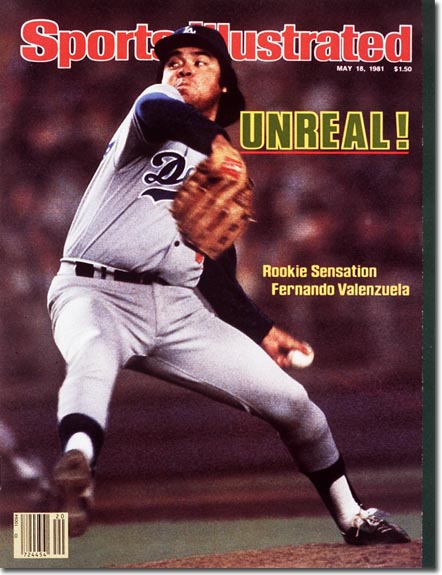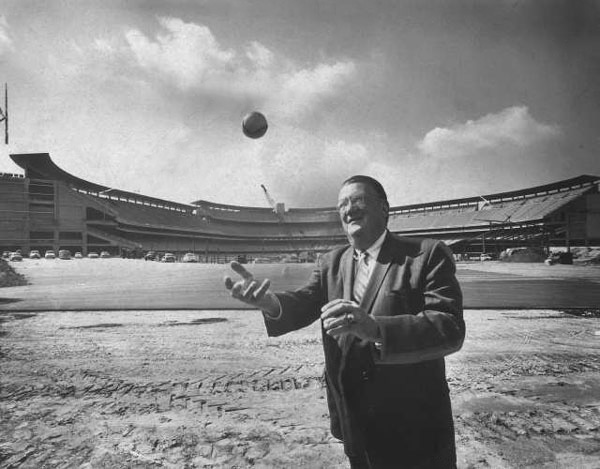(This is the first of a three-part series)
Although Jackie Robinson broke the color barrier in 1947, baseball was still primarily a white man’s sport in 1958. When the Dodgers made their move to Los Angeles, longtime Dodger owner Walter O’Malley saw something different – an opportunity in a different population. O’Malley was a savvy businessman but also a visionary in many ways. He could see trends that others couldn’t or perhaps weren’t open to see. Maybe in the back of his mind, as well, he wanted to somehow win back a Mexican-American community that was forcibly removed from Chavez Ravine to build Dodger Stadium. That is pure speculation on my part, but wherever his complicated and perhaps conflictive motives lay, he wanted to sell tickets and create a faithful fan base.
In 1959, Hall of Fame announcer, Jaime Jarrín was hired to join the Spanish language broadcast on KWKW with Rene Cardenas who initiated the broadcast proposed by O’Malley in 1958. As Jarrín has described many times on his broadcasts, O’Malley saw the potential in the Mexican-American community as a natural Dodger fan base and always wanted to find a player who could energize that population and create life-long fans. While he spent a good portion of his life looking for that one great Mexican star his dream was never realized, passing away in 1979 – only thirteen months before the emergence of Fernando Valenzuela.
Valenzuela broke into the major leagues towards the end of the 1980 season. When the 1981 season took place, Fernando-mania was well underway. Valenzuela not only won the Rookie of the Year but the Cy Young and a World Series ring.
Apart from being a great player, Fernando had a much more important effect on baseball ushering in a wave of new fans over the next decade, not only in Los Angeles but across the country and throughout Latin America. Many of those fans have Mexican roots and were inspired by Valenzuela’s personal story. As Cruz Angeles, director of ESPN’s great 30 for 30 documentary segment “Fernando Nation,” stated, “My father would use Fernando as an example of what could be achieved. If Fernando, who came from such humble beginnings, could do it, then I could accomplish anything in this country.” On a smaller scale, he even inspired a boy from Keokuk, Iowa (yours truly) to figure out where exotic places like Etchohuaquila, Sonora were on a map – even to try a screwball that sadly didn’t work out.
Valenzuela’s effect on baseball was immediate and at the same time enduring. At one point in the 80’s, there were more radio listeners to Jaime Jarrin on the Spanish language broadcasts of Dodger games than Vin Scully’s English broadcast as stations carrying the games in Spanish jumped from 3 to 17. With Fernando’s influence, the Dodgers were consistently above the 3 million mark in annual attendance through the early 80´s. While on the road in 1981, on the nights when Valenzuela pitched, he incredibly added an average of 14,000 additional tickets per game. As Jarrin stated so succinctly, “I truly believe that there is no other player in major league history who created more new fans than Fernando Valenzuela. Sandy Koufax, Don Drysdale, Joe DiMaggio, even Babe Ruth did not. Fernando turned so many people from Mexico, Central America, South America into fans. He created interest in baseball among people who did not care about baseball.” In Los Angeles, he created what every MLB executive dreams of – faithful, multi-generational fans.

“Everywhere he pitched stadiums were packed. People came from other cities when Fernando was going to pitch. I don’t think that is ever going to happen again.” – Legendary Dodgers scout Mike Brito, who discovered Fernando. (Photo courtesy of Sports Illustrated)
Fast forward to 2014. The Hispanic population is one of the fastest growing segments in the US and those with Mexican roots represent up to 70% of that population. Marketing to the burgeoning US Mexican-American population becomes the advertising industry’s main target for growth. Spanish language stations like Univision and Telemundo flourish. TV Novelas are some of the most-watched television programs in the US. Honoring Mexican roots is a source of pride.
Even though Fernando hasn’t played for the Dodgers in decades, his presence is felt beyond his broadcast from the press box. Go to a game at Dodger Stadium and ask any adult in their late 30s, 40s or even 50s when they became a Dodger fan, there is a high probability they will tell you that they became a fan in the 80’s with Fernando-mania. Take a look at the majority fan base at Dodger Stadium and you can feel the Fernando effect; you can get around very easy in Dodger stadium speaking Spanish just as well as English. As someone who speaks Spanish and has lived in Mexico for 17 years, even I feel oddly at home as well as my son who has spent his entire life in Mexico.
Many may recall when Valenzuela held out on the Dodgers for the then-scandalous million dollar contract in the 80’s. In retrospect, he was grossly underpaid. In Los Angeles, he singlehandedly created multiple generations of fans that have continued going to the games – even through the McCourt era! Apart from Walter O’Malley, Fernando Valenzuela is without a doubt the single most important figure in the shaping of the modern Dodgers fan base. That Dodger fan base and the Dodger’s organization I am sure desire the second coming of Fernando, so what is the holdup?
In actual financial terms, that is literally the million dollar or perhaps billion dollar question: Why hasn’t this been repeated? Can it be repeated? Where is the new “Fernando?” With the population shifts in the US, why hasn’t a smart MLB executive or organization been able to scout, develop, and promote a new Mexican star? Are they actively looking to do so? Why wouldn’t they be? What teams are actively searching? What is the state of baseball in Mexico? All juicy issues.
(Part two continues tomorrow)




 January 30th, 2014 at 6:00 am
January 30th, 2014 at 6:00 am  by Robb Anderson
by Robb Anderson 
 Posted in
Posted in 

RT @Think_BlueLA: New post: The search for the next Fernando (part 1) – http://t.co/PnE4Z4cORK #Dodgers
Where are you Fernando? 1 of 3 essays on @Think_BlueLA http://t.co/oYafa6zdrH @jonweisman @truebluela @Dodgers @FerAlvarez @Pelotapimienta
¿Donde estas Fernando? 1 de 3 @Think_BlueLA http://t.co/oYafa6zdrH @beisbolicos @Beisbollearn @solobeisbolmx @hdbmx @purobeisbolfb
Great stuff Robb – Looking forward to parts two and three.
When I spoke with Mike Brito this past season, he said that in spite of all of the great kids coming out of Cuba (and the few out of Mexico), there will never be another Fernando – just as there will never be another Jackie Robinson.
That being said, because of guys like Brito and with the Dodgers increasing their international scouting staff significantly over the past two years, the chances increase exponentially that these gifted kids will be discovered and will have an opportunity to fulfill their dreams.
If I were to guess and barring the unforeseen, Julio Urias will most likely become the next hard-throwing lefty out of Mexico – and then perhaps a young right-hander named Matias.
Hahaha! Prospect Matias is going to love that comment!
There is a huge population of people (including me) who are specifically want that next Mexican star. As the population continues to shift in the US, I truly believe that the popularity of baseball in the next 20 years is dependent on finding that star and making the connection with generations of new fans. There hasn’t been a real focus on Mexico or investment in finding the next Fernando for quite some time (topics coming up in articles 2 and 3). I agree with Mike Brito that there may never be another Fernando but as baseball continues to become gentrified, there needs to be a way to energize a younger crowd. Finding a true Mexican star with a great story, ability, and charisma will provide a spark for new fans like Fernando did so successfully in the 80’s.
Even before being picked up by the Dodgers at the tender age of 16, we were hearing lots of good things about Julio Urias here in Mexico. Apart from his talent, he appears to be a really nice kid. We are keeping our fingers crossed and will continue to follow his development. Prospect Matias is still a few years away.
Would you please be so kind as to have Prospect Matias autograph a Little League baseball for me so that I can say “I remember this kid when…”?
Ron, Prospect Matias was happy to oblige with an actual game-used ball. He said “Sorry for the long signature. It is not so easy to write on a ball.” He will have to practice.

I hope that I am his first autograph.
Where are you Fernando? 1 of 3 essays on @Think_BlueLA http://t.co/oYafa6zdrH @FeelinKindaBlue @rbaly79 @dodgersbuzztap @DodgersBeat
¿Donde estas Fernando? 1 de 3 @Think_BlueLA http://t.co/oYafa6zdrH @shanelly_guzman
Where are you Fernando? 1 of 3 on @Think_BlueLA http://t.co/oYafa6zdrH @markasaxon @keithlaw @BertsBall @ramonashelburne @BillShaikin
RT @MorelosLLB: ¿Donde estas Fernando? 1 de 3 @Think_BlueLA http://t.co/oYafa6zdrH @beisbolicos @Beisbollearn @solobeisbolmx @hdbmx @purobe…